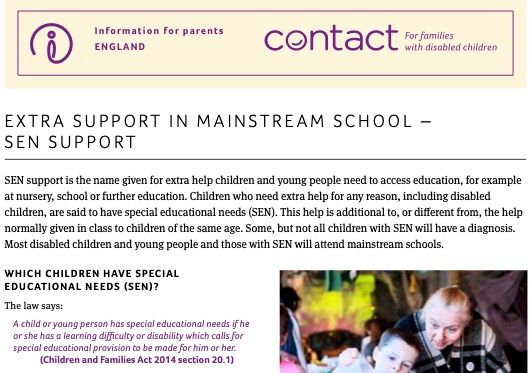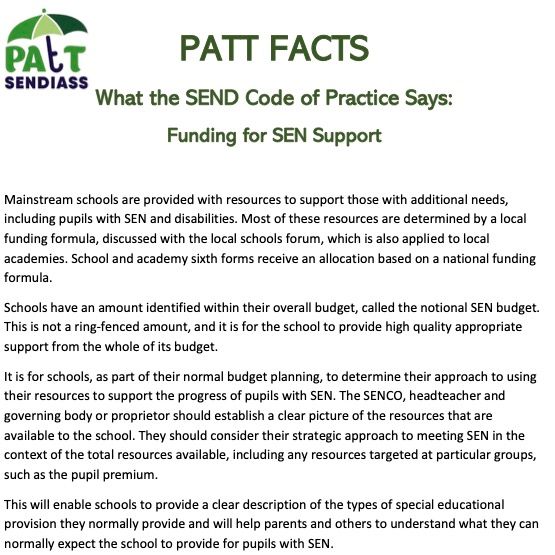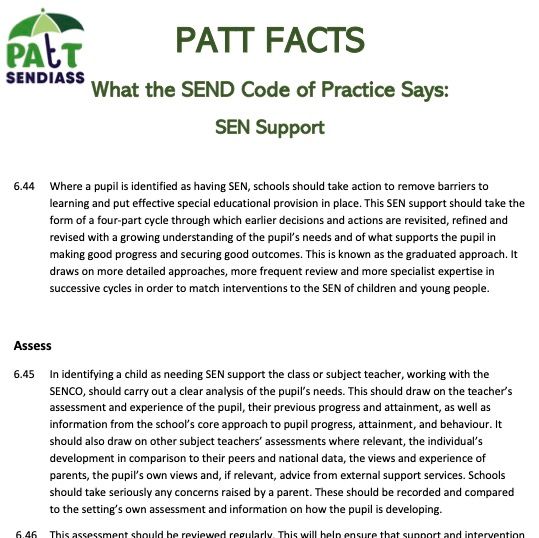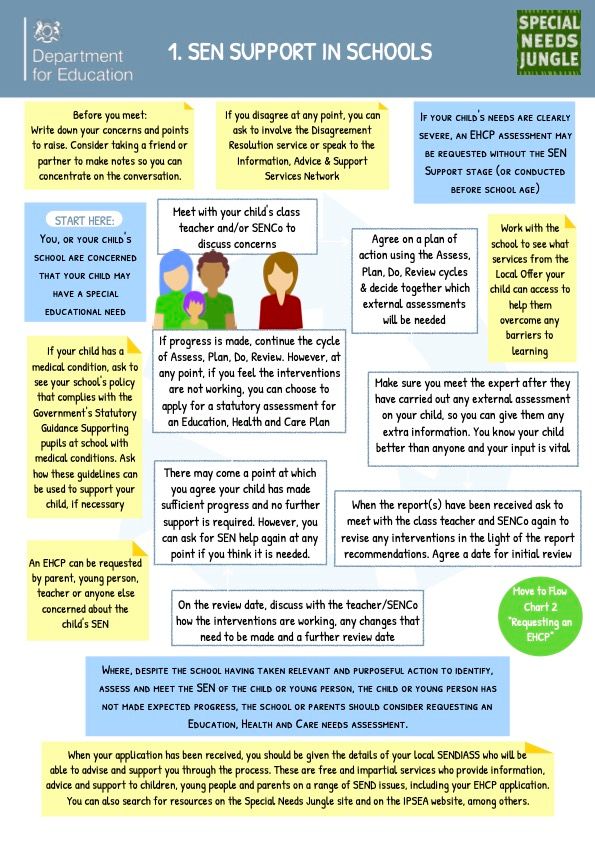What is a SEN Support profile?
The SEN Support Profile (SSP) is the collection of worksheets and “All About Me” information which is used to create a One Page Profile.
Using the principles of Person Centred Planning (see Helen Sanderson Website), we aim to build a comprehensive picture of the child/young person which should result in more effective planning and support to meet their needs.

What is SEN Support?
Every child with special educational needs should have SEN support. This means help that is additional to or different from the support generally given to other children of the same age.
The purpose of SEN support is to help children achieve the outcomes or learning objectives set for them by the school.
Schools should involve parents in this process.
Every school must publish a SEN information report, also known as the school’s “local offer” about the SEN provision the school makes. You can find this on the school’s website. You can also ask your child’s teacher or the school’s SENCO for information on the SEN provision made by the school.
SEN support can take many forms, including:
- a special learning programme for your child
- extra help from a teacher or a learning support assistant
- making or changing materials and equipment
- working with your child in a small group
- observing your child in class or at break and keeping records
- helping your child to take part in the class activities
- making sure your child has understood things by encouraging them to ask questions and to try something they find difficult
- helping other children work with your child, or play with them at break time
- supporting your child with physical or personal care, such as eating, getting around school safely, toileting or dressing.
Advice on where to start
-
What can I do?
You clearly have concerns about your child’s progress but:
Have you spoken to your child’s school about your concerns?
Do you know how the school works with children who may have special educational needs?
Does your child have an individual provision map/passport/individual education plan? (each school will have their own method of documenting a child’s needs)
-
Who should you speak to in school?
The first person to speak to is probably your child’s class teacher or form tutor. You might want to do this at a parents' evening or make a separate appointment to see them.
If you want to, you could ask for the meeting, setting out what it is you want to discuss, for example:
"Dear …
I would like to arrange to see you in school next week to talk about my child’s progress. I do not feel that child is reading as well as his sister did at the same age and would be grateful for an opportunity to discuss this with you.
I can be available during the morning/after school/at lunchtime, etc. and can be contacted on...
Yours sincerely"
We would recommend that you make this request via email, copying in the school SENCO.
If you do not get a reply within 2 school days of the request, send another this time also copying in the Headteacher and info@patt.org.uk
-
Who decides what SEN support my child has?
The SEND Code of Practice says:
Class and subject teachers, supported by the senior leadership team, should make regular assessments of progress for all pupils. These should seek to identify pupils making less than expected progress given their age and individual circumstances. (6.17)
The school should then decide if your child needs SEN support. The school should talk to you and your child about this. If a young person is 16 or older the school should involve them directly.
Sometimes you may be the first to be aware that your child has some special educational needs. If you think your child may need SEN support you should talk to your child’s teacher or to the SENCO.
If you are not happy about the support your child has you can ask to talk to the SENCO or head teacher.
-
What is a SEN Support profile?
The SEN Support Profile (SSP) is the collection of worksheets and “All About Me” information which is used to create a One Page Profile, this helps us in our aim to build a comprehensive picture of the child/young person which should result in more effective planning and support to meet their needs. Click here for more information and resources.
SEN Support in Mainstream Schools
This information is about the support that mainstream schools should provide for children with special educational needs (SEN)
The SEND Code of Practice says that:
All children and young people are entitled to an education that enables them to make progress so that they:
- achieve their best
- become confident individuals living fulfilling lives, and
- make a successful transition into adulthood, whether into employment, further or higher education or training
The duties of schools to make SEN provision
The SEND Code of Practice says all schools must:
- use their best endeavours to make sure that a child with SEN gets the support they need – this means doing everything they can to meet children and young people’s SEN
- ensure that children and young people with SEN engage in the activities of the school alongside pupils who do not have SEN
- designate a teacher to be responsible for co-ordinating SEN provision – the SENCO.
- inform parents when they are making special educational provisions for a child
- publish an SEN information report and their arrangements for the admission of disabled children, the steps being taken to prevent disabled children from being treated less favourably than others, the facilities provided to enable access to the school for disabled children and their accessibility plan showing how they plan to improve access progressively over time
What is the graduated approach?
The SEND Code of Practice says:
Where a pupil is identified as having SEN, schools should take action to remove barriers to learning and put effective special educational provision in place. (6.44)
When your child is identified has having SEN, the school should use a graduated approach based on four steps. These are:
Assess
In identifying a child as needing SEN support the class or subject teacher, working with the SENCO, should carry out a clear analysis of the pupil’s needs. This should draw on the teacher’s assessment and experience of the pupil, their previous progress and attainment, as well as information from the school’s core approach to pupil progress, attainment, and behaviour. It should also draw on other subject teachers’ assessments where relevant, the individual’s development in comparison to their peers and national data, the views and experience of parents, the pupil’s own views and, if relevant, advice from external support services. Schools should take seriously any concerns raised by a parent. These should be recorded and compared to the setting’s own assessment and information on how the pupil is developing.
This assessment should be reviewed regularly. This will help ensure that support and intervention are matched to need, barriers to learning are identified and overcome, and that a clear picture of the interventions put in place and their effect is developed. For some types of SEN, the way in which a pupil responds to an intervention can be the most reliable method of developing a more accurate picture of need.
In some cases, outside professionals from health or social services may already be involved with the child. These professionals should liaise with the school to help inform the assessments. Where professionals are not already working with school staff the SENCO should contact them if the parents agree.
Plan
Where it is decided to provide a pupil with SEN support, the parents must be formally notified, although parents should have already been involved in forming the assessment of needs as outlined above. The teacher and the SENCO should agree in consultation with the parent and the pupil the adjustments, interventions and support to be put in place, as well as the expected impact on progress, development or behaviour, along with a clear date for review.
All teachers and support staff who work with the pupil should be made aware of their needs, the outcomes sought, the support provided and any teaching strategies or approaches that are required. This should also be recorded on the school’s information system.
The support and intervention provided should be selected to meet the outcomes identified for the pupil, based on reliable evidence of effectiveness, and should be provided by staff with sufficient skills and knowledge.
Parents should be fully aware of the planned support and interventions and, where appropriate, plans should seek parental involvement to reinforce or contribute to progress at home.
Do
The class or subject teacher should remain responsible for working with the child on a daily basis. Where the interventions involve group or one-to-one teaching away from the main class or subject teacher, they should still retain responsibility for the pupil. They should work closely with any teaching assistants or specialist staff involved, to plan and assess the impact of support and interventions and how they can be linked to classroom teaching. The SENCO should support the class or subject teacher in the further assessment of the child’s particular strengths and weaknesses, in problem-solving and advising on the effective implementation of support.
Review
The effectiveness of the support and interventions and their impact on the pupil’s progress should be reviewed in line with the agreed date.
The impact and quality of the support and interventions should be evaluated, along with the views of the pupil and their parents. This should feed back into the analysis of the pupil’s needs.
The class or subject teacher, working with the SENCO, should revise the support in light of the pupil’s progress and development, deciding on any changes to the support and outcomes in consultation with the parent and pupil.
Parents should have clear information about the impact of the support and interventions provided, enabling them to be involved in planning the next steps.
We welcome your feedback! If you have used our services please click here to leave your opinion.
Contact us
Text: 07702 127 252
Text a message to request a call.
Telephone: 07702 127 252
Leave a message and you will receive a call back within 4 working days
Menu
Address
51 Lodge Lane,
Grays,
Essex.
RM17 5RZ
Email: info@patt.org.uk
All Rights Reserved | PATT SENDIASS THURROCK





